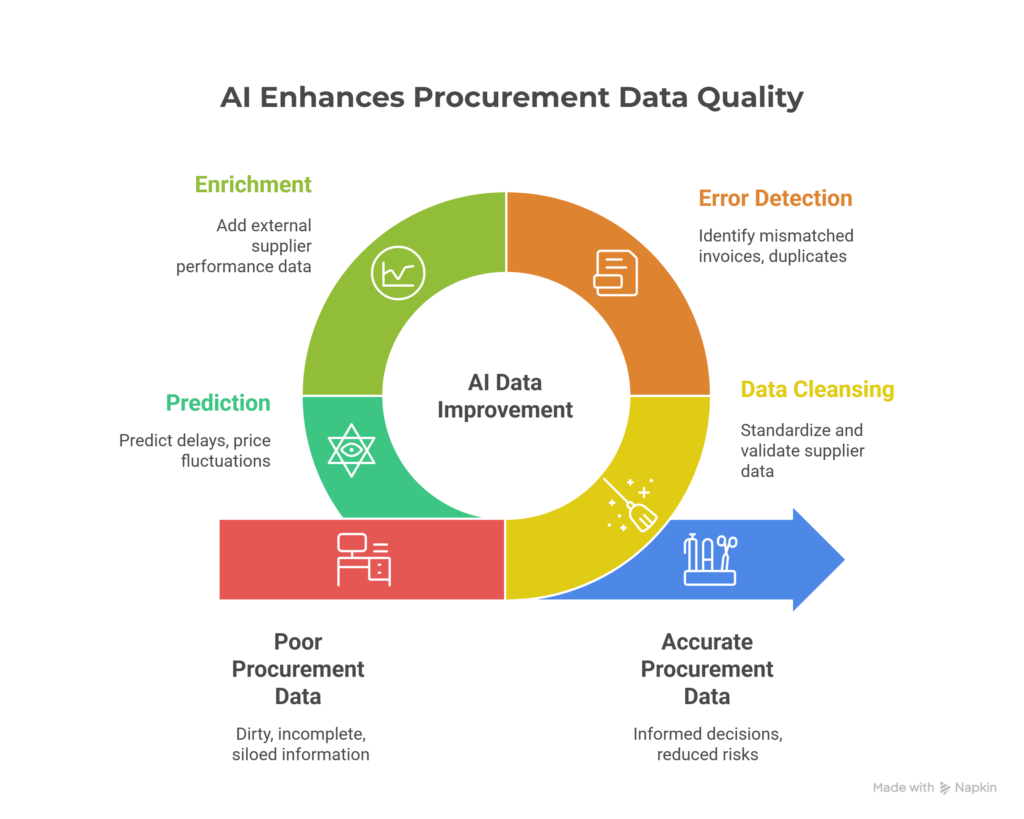Table of Contents
- What is AI in Procurement?
- Understanding AI in Procurement
- How to Leverage AI in Procurement
- How AI Improves Procurement Data and Decisions
- Key Benefits of AI in Procurement
- How to Calculate ROI for an AI Procurement Project
- Best Practices for AI Implementation in Procurement
- FAQ
- How can AI facilitate smarter procurement decisions?
- How to build clean, unified procurement data for AI?
- How do you leverage data and analytics to drive better procurement decisions?
- How do you think AI will affect the supply chain as an industry?
- What are the measurable benefits of using AI in procurement workflows?
- Conclusion
AI in procurement is no longer a future ambition—it’s today’s competitive advantage. According to Gartner, over 60% of procurement leaders believe artificial intelligence will fundamentally reshape sourcing and supplier management in the next three years. For executives navigating cost pressures, supply chain disruptions, and increasing compliance demands, the question is no longer how to adopt AI solutions for procurement data mistakes.
This guide will walk you through the essentials of AI-driven procurement decisions, practical applications, and strategies to unlock smarter, data-driven outcomes.
AI in procurement uses LLMs and Generative AI to analyze documents, predict outcomes, simulate scenarios, and proactively manage supplier risks.
What is AI in Procurement?
AI in procurement refers to the integration of artificial intelligence technologies—such as machine learning (ML), predictive analytics, natural language processing (NLP), robotic process automation (RPA), and generative AI into procurement and supply chain processes.
Rather than replacing human expertise, AI serves as a strategic partner, helping procurement leaders:
- Process vast procurement data at scale.
- Identify supplier risks and opportunities.
- Automate repetitive and compliance-heavy tasks.
- Deliver real-time decision support for sourcing, contracts, and demand forecasting.
As Gartner has noted, 65% of procurement leaders believe AI-driven procurement decisions will become standard by 2026.
Understanding AI in Procurement
To truly understand the impact of AI, it helps to visualize procurement as a vast chessboard. Each contract, supplier, and spend decision is a move—but only AI sees the whole board. It connects hidden patterns, predicts future moves, and guides leaders toward strategic wins.
Key AI technologies reshaping procurement include:
- Machine Learning (ML): Uncovers historical spend and supplier performance trends.
- Predictive Analytics: Forecasts demand, pricing shifts, and supply chain risks.
- Natural Language Processing (NLP): Analyzes complex contracts, extracting key clauses.
- Robotic Process Automation (RPA): Speeds up repetitive invoice matching and supplier onboarding.
- Generative AI (Gen AI): Creates procurement playbooks, simulations, and scenario planning models.
How to Leverage AI in Procurement
To leverage AI in procurement, leaders should focus on three steps:
Data Preparation – Ensure clean, unified procurement data. Without this, AI models produce weak or biased outputs. And see how to improve procurement data quality with AI.
Pilot Use Cases – Start small with invoice matching or spend classification. Early wins build confidence and ROI visibility.
Scale with Governance – Establish ethical AI policies aligned with ISO procurement standards and CIPS best practices.
Omnea recently raised $50 million to expand its AI-based procurement intake and orchestration platform. Their focus: eliminating fragmented requests and creating seamless intake workflows, proof that efficiency and scalability are driving AI adoption.
How AI Improves Procurement Data and Decisions
The most pressing challenge in procurement is the quality of procurement data. Dirty, incomplete, or siloed data leads to poor supplier negotiations, incorrect risk assessments, and compliance failures. Here’s how AI improves procurement data accuracy:
- Data Cleansing: NLP extracts, standardizes, and validates supplier data.
- Error Detection: AI identifies mismatched invoices, duplicate records, and compliance breaches.
- Enrichment: Adds external supplier performance data to support informed decision-making.
- Prediction: Machine learning predicts supplier delays, price fluctuations, and contract risks.
This is where leaders can apply solutions like AI improving procurement data accuracy to reduce hidden risks.

Key Benefits of AI in Procurement
Procurement leaders adopting AI report tangible, measurable benefits that directly impact both operational efficiency and strategic decision-making. By integrating machine learning, predictive analytics, and natural language processing into procurement workflows, organizations are moving from reactive cost control to proactive value creation.
- Faster Decision-Making: AI agents provide real-time negotiation and supplier scoring insights.
- Cost Savings: Automated spend analytics can uncover hidden inefficiencies and duplicate costs, often unlocking savings of 5–15% across various categories. This frees up capital for reinvestment in strategic initiatives.
- Time Efficiency: Robotic Process Automation (RPA) accelerates routine tasks such as invoice matching and supplier onboarding, cutting cycle times by as much as 60%. Teams can then focus on high-value negotiations and supplier innovation.
- Supplier Risk Management: Predictive analytics provide early warnings of supplier instability, geopolitical risks, or compliance breaches. This helps organizations build resilient supply chains in volatile markets.
- Enhanced Compliance: Natural Language Processing (NLP) tools scan and interpret complex contract clauses, reducing the need for manual legal reviews and minimizing exposure to costly disputes.
Forgent AI recently secured €4.3M to transform public procurement. Their platform uses advanced machine learning to detect inefficiencies in tendering, identify fraud risks, and streamline supplier selection. This illustrates how AI not only drives cost and efficiency gains but also enhances transparency, trust, and accountability, even in highly regulated public sector environments.
High-Impact Applications of AI in Procurement
| Use Case | AI Capability | Impact |
| Spend Analytics | Machine learning classification | Uncovers savings and compliance gaps |
| Invoice Matching | AI-powered three-way match | Automates up to 90% of processing |
| Contract Review | NLP clause extraction | Faster approvals, reduced legal risk |
| Supplier Scoring | Predictive risk modeling | Improved vendor selection and continuity |
| Demand Forecasting | Predictive analytics | Optimized inventory, reduced stockouts |
| Sourcing Automation | RPA + ML workflows | Shorter cycle times, faster onboarding |
How to Calculate ROI for an AI Procurement Project
Executives want proof. Here’s how to evaluate AI’s impact:
- Baseline Metrics – Measure current cycle times, error rates, and supplier risks.
- Define Targets – Example: 30% faster approvals, 10% cost savings.
- Track Intangibles – Include improved compliance, reduced liabilities, and agility.
Calculate Payback Period – Most AI projects show returns within 12–24 months.
A CFO-friendly formula:
ROI = (Total Benefits – Total Costs) / Total Costs x 100%
For more on risk assessment in Procurement data risks and liabilities.
Best Practices for AI Implementation in Procurement
Adopting AI in procurement is not a simple “switch-on” exercise—it’s a journey that blends technology, people, and process. Companies that succeed view AI as a strategic enabler rather than just another IT project. Here are the best practices to ensure successful adoption:
- Data Hygiene – AI is only as good as the data it learns from. Start by cleaning, structuring, and unifying procurement data across ERP, SRM, and CLM systems. This minimizes bias and ensures outputs are reliable.
- Stakeholder Buy-In – Early involvement from CFOs, IT leaders, and procurement heads is critical. This alignment ensures that AI adoption addresses both financial outcomes and operational efficiency, while avoiding tech silos or resistance from key decision-makers.
- Change Management – AI may challenge existing workflows. Training procurement teams to trust, interpret, and act on AI insights is vital. Encourage a culture of collaboration between humans and AI—where technology handles the heavy lifting, and people provide strategic oversight.
- Scalability – Start with targeted use cases like spend analytics or invoice automation, then scale to more advanced applications such as predictive supplier risk modeling or demand forecasting.
- Governance – As AI takes on a bigger role in decision-making, strong governance is essential. Follow ISO procurement standards, CIPS ethical frameworks, and establish internal AI usage policies.

FAQ
How can AI facilitate smarter procurement decisions?
AI facilitates smarter decisions by analyzing procurement data at scale, highlighting risks, and surfacing actionable insights in real-time. This reduces reliance on intuition and allows leaders to make decisions based on facts, trends, and predictive indicators.
How to build clean, unified procurement data for AI?
To build unified data, organizations should consolidate sources from SRM, CLM, and ERP systems into a single repository. AI then applies classification, de-duplication, and error correction, ensuring the foundation is reliable for analysis and automation.
How do you leverage data and analytics to drive better procurement decisions?
By combining spend analytics, supplier scoring, and predictive forecasting, procurement leaders gain a 360° view of cost, risk, and performance. This allows businesses to negotiate smarter contracts, strengthen supplier relationships, and forecast demand with greater accuracy.
How do you think AI will affect the supply chain as an industry?
AI will make supply chains more resilient and adaptive. From predictive demand forecasting to supplier risk assessment using AI, companies will shift from reacting to disruptions to proactively managing them. The future of AI in procurement is integrated, real-time, and global.
What are the measurable benefits of using AI in procurement workflows?
Benefits include faster procurement cycle times, reduced manual errors, significant cost savings, and improved supplier risk visibility. Organizations also gain better compliance tracking and decision-making speed—outcomes that directly improve business continuity and profitability.
Conclusion
Procurement leaders stand at a crossroads. With global markets facing volatility and compliance becoming stricter, the old ways of managing supplier data and decisions no longer suffice. AI offers a path forward: more accurate data, smarter decisions, and stronger supplier resilience.
Whether through predictive procurement with AI, supplier risk assessment models, or automated spend analytics, the message is clear AI in procurement is no longer optional; it’s essential. The time to act is now. Forward-looking decision-making embracing AI will transform procurement from a cost center into a strategic value driver.
Global Procurement Lead
Skilled in strategic sourcing, vendor management, and cost optimization, 7+ hands-on experience in streamlining procurement operations. Offers valuable insights into modern supply chain practices and is dedicated to helping businesses achieve efficiency and value through data-driven procurement.




